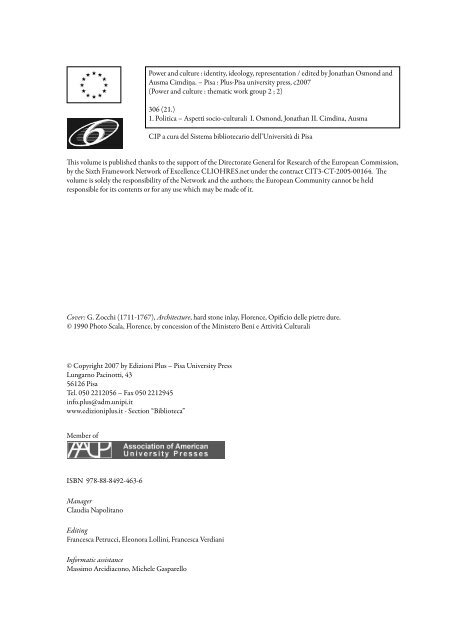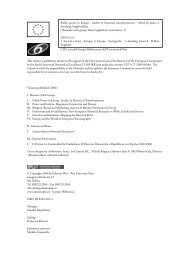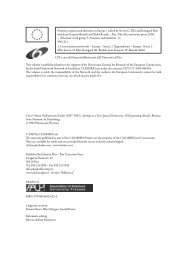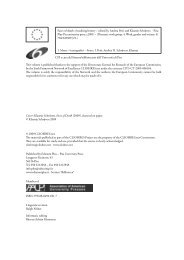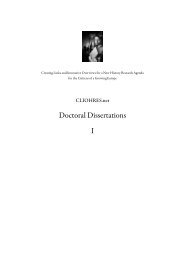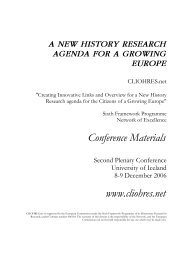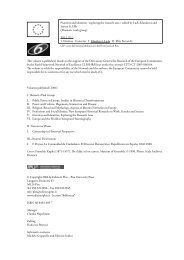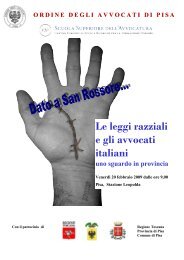Caravanserais as Symbols of Power in Seljuk Anatolia - clioh-world
Caravanserais as Symbols of Power in Seljuk Anatolia - clioh-world
Caravanserais as Symbols of Power in Seljuk Anatolia - clioh-world
- No tags were found...
Create successful ePaper yourself
Turn your PDF publications into a flip-book with our unique Google optimized e-Paper software.
<strong>Power</strong> and culture : identity, ideology, representation / edited by Jonathan Osmond andAusma Cimdiņa. – Pisa : Plus-Pisa university press, c2007(<strong>Power</strong> and culture : thematic work group 2 ; 2)306 (21.)1. Politica – Aspetti socio-culturali I. Osmond, Jonathan II. Cimd<strong>in</strong>a, AusmaCIP a cura del Sistema bibliotecario dell’Università di PisaThis volume is published thanks to the support <strong>of</strong> the Directorate General for Research <strong>of</strong> the European Commission,by the Sixth Framework Network <strong>of</strong> Excellence CLIOHRES.net under the contract CIT3-CT-2005-00164. Thevolume is solely the responsibility <strong>of</strong> the Network and the authors; the European Community cannot be heldresponsible for its contents or for any use which may be made <strong>of</strong> it.Cover: G. Zocchi (1711-1767), Architecture, hard stone <strong>in</strong>lay, Florence, Opificio delle pietre dure.© 1990 Photo Scala, Florence, by concession <strong>of</strong> the M<strong>in</strong>istero Beni e Attività Culturali© Copyright 2007 by Edizioni Plus – Pisa University PressLungarno Pac<strong>in</strong>otti, 4356126 PisaTel. 050 2212056 – Fax 050 2212945<strong>in</strong>fo.plus@adm.unipi.itwww.edizioniplus.it - Section “Biblioteca”Member <strong>of</strong>ISBN 978-88-8492-463-6ManagerClaudia NapolitanoEdit<strong>in</strong>gFrancesca Petrucci, Eleonora Loll<strong>in</strong>i, Francesca VerdianiInformatic <strong>as</strong>sistanceM<strong>as</strong>simo Arcidiacono, Michele G<strong>as</strong>parello
52 Mustafa ÖngeHowever, this expansion w<strong>as</strong> <strong>in</strong>terrupted by the crusades and Byzant<strong>in</strong>e attacks <strong>in</strong> theearly 12th century, and the <strong>Seljuk</strong>s were forced to retreat to more central parts <strong>of</strong> <strong>Anatolia</strong>12 . By the end <strong>of</strong> the 12th century, the <strong>Seljuk</strong>s had achieved political stability andplaced special importance on economic improvement. From the reign <strong>of</strong> KılıçarslanII, the policies and military activities <strong>of</strong> the <strong>Seljuk</strong> sultans focused on the development<strong>of</strong> commerce <strong>in</strong> their lands. This w<strong>as</strong> why they constructed caravanserais on caravanroutes and formed organisations <strong>of</strong> guardsman, called derbent, <strong>in</strong> order to provide securityand to encourage merchants 13 .Map 1Map <strong>of</strong> <strong>Seljuk</strong> <strong>Anatolia</strong> show<strong>in</strong>g the important trade routes and commercial centers.Source: Redrawn after: Özerg<strong>in</strong>, 1965.There are three sultans whose contributions to this process are worth consider<strong>in</strong>g. Thefirst is Gıy<strong>as</strong>edd<strong>in</strong> Keyhüsrev, the sixth ruler <strong>of</strong> the <strong>Anatolia</strong>n <strong>Seljuk</strong>s. Keyhüsrev conqueredAntalya, an important Mediterranean port at the time. Accord<strong>in</strong>g to the sources,he <strong>in</strong>tended to organise a Turkish commercial colony <strong>in</strong> Antalya 14 . Keyhüsrev alsoencouraged merchants through certa<strong>in</strong> tax exemptions and announced that any lossesoccurred <strong>in</strong> c<strong>as</strong>es <strong>of</strong> robbery would be <strong>in</strong>demnified 15 . Another <strong>Seljuk</strong> sultan, İzzedd<strong>in</strong>Keykavus, ma<strong>in</strong>ta<strong>in</strong>ed similar policies and conquered S<strong>in</strong>op, an important Black Seaport. Dur<strong>in</strong>g his reign, the <strong>Seljuk</strong> state signed important agreements with the LusignanK<strong>in</strong>gdom <strong>of</strong> Cyprus and the Venetians about the immigration rights <strong>of</strong> merchants,freedom <strong>of</strong> movement, and tax reductions. This w<strong>as</strong> <strong>in</strong> order to attract European merchantswho were preferr<strong>in</strong>g the ports <strong>of</strong> Cyprus 16 .
<strong>Caravanserais</strong> <strong>as</strong> <strong>Symbols</strong> <strong>of</strong> <strong>Power</strong> <strong>in</strong> <strong>Seljuk</strong> <strong>Anatolia</strong> 53The economic and political power <strong>of</strong> the <strong>Seljuk</strong>s dur<strong>in</strong>g the reign <strong>of</strong> Sultan Alaedd<strong>in</strong>Keykubad h<strong>as</strong> led many scholars to view him <strong>as</strong> the greatest <strong>of</strong> all the <strong>Seljuk</strong> sultans.Alaedd<strong>in</strong>’s conquest <strong>of</strong> Kalonoros, a c<strong>as</strong>tle on the Mediterranean co<strong>as</strong>t, w<strong>as</strong> an importantevent. After the conquest, the surround<strong>in</strong>g settlement w<strong>as</strong> developed and renamedAlaiyye by order <strong>of</strong> the Sultan. Alaiyye, a reference to Sultan Alaedd<strong>in</strong>’s name, becameanother important port for the <strong>Anatolia</strong>n <strong>Seljuk</strong>s. The <strong>Seljuk</strong> sultans used it <strong>as</strong> theirw<strong>in</strong>ter residence 17 . Sultan Alaedd<strong>in</strong> advanced Gıy<strong>as</strong>edd<strong>in</strong> Keyhusrev’s <strong>in</strong>demnificationpolicy and <strong>in</strong>troduced a k<strong>in</strong>d <strong>of</strong> commercial <strong>in</strong>surance for merchants. The standards <strong>of</strong>the caravan roads were greatly enhanced through his efforts, and the largest surviv<strong>in</strong>gcaravanserais were built <strong>in</strong> this period.Follow<strong>in</strong>g the conquest <strong>of</strong> significant Mediterranean and Black Sea ports, the cities <strong>of</strong>central <strong>Anatolia</strong> ga<strong>in</strong>ed importance <strong>as</strong> commercial centres. Incre<strong>as</strong><strong>in</strong>g commercial trafficon the connect<strong>in</strong>g trade routes resulted <strong>in</strong> the construction <strong>of</strong> new caravanserais 18 .The commercial development policy <strong>of</strong> the <strong>Seljuk</strong>s cont<strong>in</strong>ued even after the battle <strong>of</strong>Kösedağ <strong>in</strong> 1242, when they were forced to accept Mongol rule. In the years that followed,despite warfare and political <strong>in</strong>stability, caravanserai constructions were ma<strong>in</strong>ta<strong>in</strong>eduntil the late 13th century when the <strong>Anatolia</strong>n <strong>Seljuk</strong> era came to an end 19 .An estimated 300 caravanserais were built dur<strong>in</strong>g the <strong>Anatolia</strong>n <strong>Seljuk</strong> period 20 . Thesebuild<strong>in</strong>gs were donated by the sultans, members <strong>of</strong> the <strong>Seljuk</strong> dyn<strong>as</strong>ty, or importantstatesmen, and were f<strong>in</strong>anced by their foundations, called vaqf. Accord<strong>in</strong>g to the surviv<strong>in</strong>gcharters <strong>of</strong> these foundations, caravanserais were mostly non-pr<strong>of</strong>it mak<strong>in</strong>g <strong>in</strong>stitutionsand had different sources <strong>of</strong> <strong>in</strong>come depend<strong>in</strong>g on their sizes and programmes 21 .Besides the caravanserais’ own sources, their <strong>in</strong>comes came from other parts <strong>of</strong> the vaqfsystem, <strong>in</strong>clud<strong>in</strong>g tax generated from the villages and rental revenues from the shops orhouses. In addition to these, some non-monetary sources were used to meet the dailyneeds <strong>of</strong> travellers 22 . Apparently, the vaqf system allowed for the functional cont<strong>in</strong>uity<strong>of</strong> the caravanserais and enabled them to cont<strong>in</strong>ue after the death <strong>of</strong> their donors.The largest rema<strong>in</strong><strong>in</strong>g <strong>Seljuk</strong> caravanserais are mostly located on the trade route extend<strong>in</strong>gfrom the Mediterranean ports to the e<strong>as</strong>t, via Antalya, Konya, and Kayseri 23 . Accord<strong>in</strong>gto the sources, this w<strong>as</strong> the busiest commercial route <strong>in</strong> <strong>Seljuk</strong> <strong>Anatolia</strong>, whichw<strong>as</strong> also used for adm<strong>in</strong>istrative and diplomatic purposes. From the reign <strong>of</strong> Alaedd<strong>in</strong>Keykubad, <strong>Anatolia</strong>n <strong>Seljuk</strong>s had mobile governments, chang<strong>in</strong>g their locations accord<strong>in</strong>gto political conditions or se<strong>as</strong>ons. This route and its manzils were used by thesultans while travell<strong>in</strong>g between the adm<strong>in</strong>istrative centres <strong>of</strong> Konya, Kayseri, Alaiyyeand Kubad-Abad 24 . The route w<strong>as</strong> also used by diplomatic visitors 25 .<strong>Caravanserais</strong> <strong>as</strong> symbols <strong>of</strong> powerFrom the 12th century, the caravanserais <strong>of</strong> the <strong>Seljuk</strong> rul<strong>in</strong>g cl<strong>as</strong>s became symbols <strong>of</strong>their adm<strong>in</strong>istrative and economic power <strong>in</strong> <strong>Anatolia</strong>n <strong>Seljuk</strong> lands. The caravanserai isone <strong>of</strong> the most significant types <strong>of</strong> build<strong>in</strong>g <strong>in</strong> <strong>Seljuk</strong> architecture. The ways <strong>in</strong> whichthese build<strong>in</strong>gs represent power relationships is worthy <strong>of</strong> exam<strong>in</strong>ation. Unfortunately,Architecture and <strong>Power</strong> <strong>in</strong> the Ottoman and Turkish States
54 Mustafa Öngemany caravanserais erected <strong>in</strong> the <strong>Anatolia</strong>n <strong>Seljuk</strong> era have not survived. However,architectural read<strong>in</strong>gs <strong>of</strong> those that rema<strong>in</strong> provide an <strong>in</strong>sight to the adm<strong>in</strong>istrative andf<strong>in</strong>ancial roles <strong>of</strong> <strong>Seljuk</strong> statesmen and members <strong>of</strong> the dyn<strong>as</strong>ty <strong>in</strong> caravanserai constructionpolicies.Compar<strong>in</strong>g the sizes <strong>of</strong> the exist<strong>in</strong>g caravanserais can act <strong>as</strong> a start<strong>in</strong>g po<strong>in</strong>t for analysis.In order to provide a scale for this comparison, present day methods <strong>of</strong> estimat<strong>in</strong>gbuild<strong>in</strong>g costs give some idea 26 . Consider<strong>in</strong>g the same types <strong>of</strong> build<strong>in</strong>g, with similarbuild<strong>in</strong>g programmes and construction materials, one might generally <strong>as</strong>sume that thelarger the build<strong>in</strong>g, the more it costs. Us<strong>in</strong>g a similar approach, the scale <strong>of</strong> the caravanseraisgive a rough idea <strong>of</strong> their build<strong>in</strong>g costs which can be l<strong>in</strong>ked to their donors’ f<strong>in</strong>ancialpowers. In this context, the b<strong>as</strong>e are<strong>as</strong> <strong>of</strong> some <strong>Seljuk</strong> caravanserais are displayed<strong>in</strong> two charts with similar scale l<strong>in</strong>es 27 . The first comprises 36 caravanserais listed <strong>in</strong>chronological order, while the second comprises 21 caravanserais from the same period,the construction dates <strong>of</strong> which are unknown 28 . For both charts, dark gray <strong>in</strong>dicatesthe caravanserais donated by sultans, so-called “Sultan Hans”, while black shows thosedonated by important viziers who possessed rul<strong>in</strong>g powers like those <strong>of</strong> the sultans 29 .Fig. 1B<strong>as</strong>e area comparison charts for compar<strong>in</strong>g the sizes <strong>of</strong> some significant <strong>Anatolia</strong>n <strong>Seljuk</strong> caravanserais.
<strong>Caravanserais</strong> <strong>as</strong> <strong>Symbols</strong> <strong>of</strong> <strong>Power</strong> <strong>in</strong> <strong>Seljuk</strong> <strong>Anatolia</strong> 55This chart shows that the largest b<strong>as</strong>e are<strong>as</strong> <strong>of</strong> these caravanserais are those <strong>of</strong> AksaraySultan Han, Tuzhisarı Sultan Han and Evdir Han. Aksaray Sultan Han is the largest<strong>of</strong> all the <strong>Anatolia</strong>n <strong>Seljuk</strong> caravanserais. The chart shows five surviv<strong>in</strong>g Sultan Hans;however, there may be more <strong>in</strong> <strong>Seljuk</strong> <strong>Anatolia</strong> <strong>of</strong> which we are unaware 30 . Anothernoteworthy po<strong>in</strong>t is the significant number <strong>of</strong> grand scale caravanserais that were constructedbetween 1219 and 1236, dur<strong>in</strong>g the rule <strong>of</strong> Sultan Alaedd<strong>in</strong> Keykubad 31 . Thisis not surpris<strong>in</strong>g <strong>as</strong> many sources mention his <strong>in</strong>terest and f<strong>in</strong>ancial participation <strong>in</strong> thedevelopment and construction <strong>of</strong> public facilities 32 . On the other hand, one <strong>of</strong> the caravanserais(donated by a vizier) <strong>in</strong> this chart seems to have a re<strong>as</strong>onably large b<strong>as</strong>e are<strong>as</strong>imilar to the Sultan Hans. This vizier w<strong>as</strong> Celaledd<strong>in</strong> Karatay, who achieved powerexceed<strong>in</strong>g some <strong>of</strong> the sultans <strong>of</strong> his day. His caravanserai is also larger than that <strong>of</strong>Sultan Gıy<strong>as</strong>edd<strong>in</strong> Keyhusrev II, one <strong>of</strong> the sultans whom he served. Among the build<strong>in</strong>gslisted <strong>in</strong> the chart, Kadın Han and Hatun Han are particularly significant <strong>as</strong> theywere caravanserais donated by powerful women <strong>of</strong> the <strong>Seljuk</strong> dyn<strong>as</strong>ty 33 . Although theircaravanserais are smaller than those <strong>of</strong> many statesmen, they are important examplestestify<strong>in</strong>g to the existence <strong>of</strong> such women <strong>in</strong> <strong>Seljuk</strong> society.We should also exam<strong>in</strong>e the adm<strong>in</strong>istrative and f<strong>in</strong>ancial roles <strong>of</strong> <strong>Seljuk</strong> statesmen <strong>in</strong>terms <strong>of</strong> build<strong>in</strong>g-donor relationships. Two prom<strong>in</strong>ent viziers <strong>of</strong> the <strong>Seljuk</strong>s and thecaravanserais that they donated are particularly worthy <strong>of</strong> mention. One <strong>of</strong> these w<strong>as</strong>Sadedd<strong>in</strong> Köpek. Besides be<strong>in</strong>g a versatile statesman, he w<strong>as</strong> also an architect who carriedout important construction work for Sultan Alaedd<strong>in</strong> 34 . Accord<strong>in</strong>g to the sources,Sadedd<strong>in</strong> gradually ga<strong>in</strong>ed power after the death <strong>of</strong> Alaedd<strong>in</strong> <strong>in</strong> 1236, and quite possiblyrema<strong>in</strong>ed the most powerful man until his death at the hands <strong>of</strong> Sultan Gıy<strong>as</strong>edd<strong>in</strong>Keyhusrev II 35 . The other prom<strong>in</strong>ent vizier w<strong>as</strong> Celaledd<strong>in</strong> Karatay, who ga<strong>in</strong>ed powerafter the death <strong>of</strong> Sadedd<strong>in</strong> Köpek, dur<strong>in</strong>g the reign <strong>of</strong> Gıy<strong>as</strong>edd<strong>in</strong> Keyhüsrev II. Afterthe death <strong>of</strong> the sultan, he also played an active adm<strong>in</strong>istrative role <strong>in</strong> preserv<strong>in</strong>g theunity <strong>of</strong> the state 36 . These two viziers are important to this study because their significantadm<strong>in</strong>istrative powers exceeded the power <strong>of</strong> the sultan, who w<strong>as</strong> described by severalsources <strong>as</strong> an <strong>in</strong>adequate ruler 37 .In comparison with other build<strong>in</strong>gs <strong>of</strong> the same era, both Karatay Han and Sadedd<strong>in</strong>Han (named after their donors) are significant caravanserais <strong>in</strong> terms <strong>of</strong> their locationsand architectural programmes. Sadedd<strong>in</strong> Han is located <strong>in</strong> the north-e<strong>as</strong>t <strong>of</strong> Konya (thecapital <strong>of</strong> the <strong>Anatolia</strong>n <strong>Seljuk</strong>s), probably on the first manzil <strong>of</strong> the route extend<strong>in</strong>g toKayseri via Aksaray from Konya. Karatay Han is located <strong>in</strong> the e<strong>as</strong>t <strong>of</strong> Kayseri, anothermanzil on the e<strong>as</strong>t end <strong>of</strong> the route which extends to the south through Dam<strong>as</strong>cus. Thelocations <strong>of</strong> both caravanserais are important <strong>as</strong> they were close to important centres<strong>of</strong> adm<strong>in</strong>istration and possessed commercial potential. However there is an additionalfactor which <strong>in</strong>cre<strong>as</strong>ed the commercial importance <strong>of</strong> this route: the existence <strong>of</strong> a great<strong>in</strong>ternational bazaar called Yabanlu Pazarı, near Kayseri, <strong>in</strong> which a great variety <strong>of</strong>goods brought from the different countries around <strong>Anatolia</strong> were on sale 38 . The advantageouslocations <strong>of</strong> Sadedd<strong>in</strong> Han and Karatay Han must have provided prestigeand a considerable amount <strong>of</strong> f<strong>in</strong>ancial <strong>in</strong>come to their donors. The sources state thatArchitecture and <strong>Power</strong> <strong>in</strong> the Ottoman and Turkish States
56 Mustafa Öngethese build<strong>in</strong>gs were the preferred stop-over locations <strong>of</strong> the sultans when lead<strong>in</strong>g theirarmies dur<strong>in</strong>g the campaigns. They were also used for welcom<strong>in</strong>g or farewell ceremonies39 . The architectural programmes <strong>of</strong> the caravanserais are also evidence <strong>of</strong> such features.This <strong>in</strong>cludes the b<strong>as</strong>e are<strong>as</strong> <strong>of</strong> Sadedd<strong>in</strong> Han and Karatay Han mentioned earlier.The other feature requires more detail and concerns certa<strong>in</strong> spaces <strong>in</strong> these build<strong>in</strong>gswhich not only support the commercial stop-over function <strong>of</strong> the build<strong>in</strong>g, but alsoprovided comfort to important visitors.In general, the layout <strong>of</strong> <strong>Anatolia</strong>n <strong>Seljuk</strong> caravanserais w<strong>as</strong> comprised <strong>of</strong> two sections:‘shelter’ and ‘services’. The shelter w<strong>as</strong> a closed space used for accommodat<strong>in</strong>g se<strong>as</strong>onaltravellers and animals <strong>in</strong> the caravan. The ‘services’ section consists <strong>of</strong> semi-open orsmall closed spaces with different functions, such <strong>as</strong> private rooms, storage rooms, m<strong>as</strong>jid,a kitchen and lavatories, around a courtyard 40 . The presence and size <strong>of</strong> the shelterand service sections also depended on the scale and programme <strong>of</strong> the caravanserais.Unusual spaces arranged <strong>in</strong> a particular way, comb<strong>in</strong>ed with certa<strong>in</strong> architectural elements,provide evidence <strong>of</strong> use by important visitors. In the services sections <strong>of</strong> bothSadedd<strong>in</strong> Han and Karatay Han, particular spatial arrangements, consist<strong>in</strong>g <strong>of</strong> threecells, are noteworthy 41 . Although many <strong>of</strong> the spaces <strong>in</strong> these caravanserais were accesseddirectly through the courtyard, only one cell <strong>in</strong> each space group had a door thatopened on to the courtyard. In order to access the other two cells, one had first to en-Fig. 2Plans <strong>of</strong> Sadedd<strong>in</strong> Han and Karatay Han.Source for the plan <strong>of</strong> Karatay Han: Yavuz, 1995.
<strong>Caravanserais</strong> <strong>as</strong> <strong>Symbols</strong> <strong>of</strong> <strong>Power</strong> <strong>in</strong> <strong>Seljuk</strong> <strong>Anatolia</strong> 59forces. Without structural system analyses it is very difficult to answer questions aboutthe location and number <strong>of</strong> these important structural elements. Ögel also accepts thekiosk m<strong>as</strong>jid <strong>in</strong> some <strong>of</strong> the caravanserais <strong>as</strong> one <strong>of</strong> the components support<strong>in</strong>g the image<strong>of</strong> the ruler 47 . Like her previous <strong>as</strong>sertion, this leads to an open ended discussion<strong>of</strong> symbols that also concern other architectural issues such <strong>as</strong> space articulation andbuild<strong>in</strong>g programmes.Fig. 4Sadedd<strong>in</strong> Han, South and west facades.Source: M. Önge photo archive.Aside from the architectural elements, other figures employed <strong>in</strong> the decoration <strong>of</strong><strong>Anatolia</strong>n <strong>Seljuk</strong> Caravanserai architecture can also be discussed <strong>in</strong> the context <strong>of</strong>power symbols. Two figures <strong>in</strong> particular, the lion and the bird <strong>of</strong> prey, are worthy <strong>of</strong>note. The lion w<strong>as</strong> one <strong>of</strong> the most widely used symbols <strong>in</strong> <strong>Seljuk</strong> culture. Throughouthistory, many civilizations have <strong>as</strong>sociated the lion with power, grandeur and dom<strong>in</strong>ance48 . The <strong>Seljuk</strong>s frequently used the word <strong>as</strong>lan [lion] <strong>in</strong> the names <strong>of</strong> their sultansand statesmen, such <strong>as</strong> Alparslan [brave lion], Aslandoğmuş [born lion] and Aslanşah[lion k<strong>in</strong>g] 49 . Four <strong>of</strong> the <strong>Seljuk</strong> sultans were named <strong>as</strong> Kılıçarslan, a word that comb<strong>in</strong>edkılıç [sword] and arslan, respectively. This <strong>in</strong>terest is clearly reflected <strong>in</strong> the artand architecture <strong>of</strong> the <strong>Anatolia</strong>n <strong>Seljuk</strong> period. In <strong>Seljuk</strong> caravanserais, lion figuresexist <strong>in</strong> the forms <strong>of</strong> statues, water spouts, consoles and mould<strong>in</strong>gs, which were generallyplaced <strong>in</strong> highly visible locations, with smooth undecorated backgrounds, highup 50 . The lion statues on <strong>Seljuk</strong> caravanserais seem to have been re-used from Roman orArchitecture and <strong>Power</strong> <strong>in</strong> the Ottoman and Turkish States
60 Mustafa ÖngePhrygian monuments, while certa<strong>in</strong> mould<strong>in</strong>gs seem to have been newly made. In additionto those shaped <strong>in</strong> the form <strong>of</strong> a lion head, some <strong>of</strong> the water spouts used <strong>in</strong> <strong>Seljuk</strong>caravanserais are very characteristic <strong>in</strong> appearance. For <strong>in</strong>stance, the water spouts onKaratay Han, hav<strong>in</strong>g a dragon-like appearance with a snake <strong>in</strong> their mouths, are rem<strong>in</strong>iscent<strong>of</strong> the gargoyles <strong>in</strong> Gothic cathedrals. Accord<strong>in</strong>g to Öney, these figures, whichhad roots <strong>in</strong> <strong>Anatolia</strong>n culture, symbolize the combat between the powerful ruler andhis enemy 51 .Fig. 5Water spout from Karatay Han near Kayseri.Source: M. Önge photo archive.Perhaps the most <strong>in</strong>terest<strong>in</strong>g example amongst the lion figures used <strong>in</strong> <strong>Seljuk</strong> caravanseraisis the sui generis candle holders <strong>of</strong> Alara Han, near Alanya, where abstract lion headfigures are used on the <strong>in</strong>terior.A significant example <strong>of</strong> the use <strong>in</strong> statue form is the two lion figures located on theportal <strong>of</strong> Çardak Han, near Denizli. These statues were placed on both sides <strong>of</strong> the<strong>in</strong>scription panel on consoles with muqarn<strong>as</strong> and appear to have been recycled fromearlier works. The two lion-head shaped spr<strong>in</strong>gers at the iwan <strong>of</strong> Ak Han near Denizliare also worth mention<strong>in</strong>g. These are abstract figures <strong>of</strong> lion heads carved on whitemarble.
<strong>Caravanserais</strong> <strong>as</strong> <strong>Symbols</strong> <strong>of</strong> <strong>Power</strong> <strong>in</strong> <strong>Seljuk</strong> <strong>Anatolia</strong> 61Fig. 6Candle holder from Alara Han near Alanya.Source: M. Önge photo archive.Fig. 7Spr<strong>in</strong>gers at the iwan <strong>of</strong> Ak Han near Denizli.Source: M. Önge photo archive.Architecture and <strong>Power</strong> <strong>in</strong> the Ottoman and Turkish States
62 Mustafa ÖngeIn this example, the artist seems to have emph<strong>as</strong>ized the lion heads us<strong>in</strong>g white marble,differentiat<strong>in</strong>g them from the other stones <strong>of</strong> the <strong>as</strong>hlar wall. On the portal <strong>of</strong> İncir Hanat Bucak, there is another significant mould<strong>in</strong>g which depicts the side view <strong>of</strong> a lionwith ris<strong>in</strong>g sun beh<strong>in</strong>d it 52 .Fig. 8Lion and sun figure on the portal <strong>of</strong> İncir Han, and the co<strong>in</strong>s <strong>of</strong> Sultan Gıy<strong>as</strong>edd<strong>in</strong> II period.Source: M. Önge photo archive.This is a well known motif, called şir-i hurşid, which w<strong>as</strong> also used on the co<strong>in</strong>s <strong>of</strong> SultanGıy<strong>as</strong>edd<strong>in</strong> II. Bear<strong>in</strong>g <strong>in</strong> m<strong>in</strong>d that İncir han w<strong>as</strong> a Sultan Han donated by SultanGıy<strong>as</strong>edd<strong>in</strong> II, this version <strong>of</strong> şir-i hurşid can be <strong>in</strong>terpreted <strong>as</strong> a royal symbol derivedfrom an exist<strong>in</strong>g symbol <strong>of</strong> power 53 .The figure <strong>of</strong> the bird <strong>of</strong> prey w<strong>as</strong> also used frequently <strong>in</strong> old <strong>Seljuk</strong> culture, and w<strong>as</strong><strong>as</strong>sociated with respect and power 54 .As a holy animal, the double-headed eagle w<strong>as</strong> accepted <strong>in</strong> Turkish culture <strong>as</strong> the guard<strong>of</strong> the door <strong>of</strong> the sky’s fifth level 55 . Like the names that <strong>in</strong>cluded “<strong>as</strong>lan”, the names <strong>of</strong>many Turkish commanders and statesmen <strong>in</strong>cluded Togan, Tugrul, Çagrı and Sungur,each <strong>of</strong> which refer to a different type <strong>of</strong> bird <strong>of</strong> prey. Sources and rema<strong>in</strong>s show thatthe bird figures were also used on royal build<strong>in</strong>gs or objects <strong>as</strong> the power symbol <strong>of</strong> thesultan 56 . The <strong>Seljuk</strong>s seem<strong>in</strong>gly preferred to use the double headed version <strong>of</strong> the eaglefigure, examples <strong>of</strong> which can be seen <strong>in</strong> works <strong>of</strong> art from the <strong>Seljuk</strong> period. Many
<strong>Caravanserais</strong> <strong>as</strong> <strong>Symbols</strong> <strong>of</strong> <strong>Power</strong> <strong>in</strong> <strong>Seljuk</strong> <strong>Anatolia</strong> 63Fig. 9Bird figure on the portal <strong>of</strong> Karatay Han.Source: M. Önge photo archive.scholars have accepted the eagle <strong>as</strong> a heraldic symbol on the b<strong>as</strong>is <strong>of</strong> its extensive use onthe royal symbols and royal build<strong>in</strong>gs <strong>of</strong> the <strong>Anatolia</strong>n <strong>Seljuk</strong>s. Accord<strong>in</strong>g to Peker, thepeople or even the sultan himself could have <strong>in</strong>terpreted the double headed eagle <strong>as</strong> thesymbol <strong>of</strong> God’s power on earth, and subsequently, <strong>as</strong> the embodiment <strong>of</strong> the sultan’spower. Accord<strong>in</strong>g to Peker, the eagle may not be an emblem <strong>of</strong> any particular ruler, butrather a symbol <strong>of</strong> earthly power granted by God 57 . However, unlike the widespread use<strong>of</strong> lion figures, bird figures used <strong>in</strong> caravanserais were smaller and generally limited toarchitectural decorations on portals. In relation to travell<strong>in</strong>g conditions and the functions<strong>of</strong> caravanserais, Öney argues that <strong>as</strong>ide from decorative re<strong>as</strong>ons, eagle figures mayalso have been <strong>in</strong>terpreted <strong>as</strong> amulets for good luck or good weather 58 . For example, <strong>in</strong>Karatay Han and Ak Han, there are two bird figures on the portal <strong>of</strong> each build<strong>in</strong>g,carved on the capitals <strong>of</strong> the corner columns. The donor <strong>of</strong> Ak Han w<strong>as</strong> a statesmancalled Kar<strong>as</strong>ungur, and so the bird figure might be a reference to his name, which means“black falcon” 59 .ConclusionIt can be argued that the primary function <strong>of</strong> the <strong>Anatolia</strong>n <strong>Seljuk</strong> caravanserai w<strong>as</strong>commercial. On the other hand, it also had features which made the build<strong>in</strong>g itself <strong>as</strong>ymbol <strong>of</strong> power. <strong>Anatolia</strong>n <strong>Seljuk</strong> caravanserais existed <strong>as</strong> the results <strong>of</strong> sultans’ <strong>in</strong>ter-Architecture and <strong>Power</strong> <strong>in</strong> the Ottoman and Turkish States
64 Mustafa Öngeest <strong>in</strong> commercial activities, which were directly related to the state’s economic status.The state also needed efficient sources <strong>of</strong> <strong>in</strong>come to cope with the difficulties <strong>of</strong> developmentand military superiority <strong>in</strong> a new settlement. However, the caravan routes werealso used by the sultan, his court and his army. Therefore, the conditions <strong>of</strong> stop-overlocations must have been developed <strong>in</strong> consideration <strong>of</strong> both royal and commercialrequirements. The existence <strong>of</strong> some special spaces and the <strong>in</strong>cre<strong>as</strong><strong>in</strong>g b<strong>as</strong>e are<strong>as</strong> <strong>of</strong> thecaravanserais, due to the grow<strong>in</strong>g architectural programme requirements, can be seen<strong>as</strong> evidence <strong>of</strong> such developments.The different scales <strong>of</strong> the caravanserais appear to depend on the grandeur <strong>of</strong> the donors<strong>in</strong> terms <strong>of</strong> the f<strong>in</strong>ancial and rul<strong>in</strong>g power. The large scale <strong>of</strong> the caravanserais donatedby prom<strong>in</strong>ent figures <strong>of</strong> the <strong>Seljuk</strong> era support this idea. The animal motifs placed ondifferent parts <strong>of</strong> the caravanserais are also significant to our topic. The presence <strong>of</strong>similar figures <strong>in</strong> Turkish-Islamic cosmology and mythology, Turkish epithets, and <strong>in</strong>other realms <strong>of</strong> <strong>Seljuk</strong> art, <strong>in</strong>clud<strong>in</strong>g metal work on royal representation, can be seen <strong>as</strong>evidence for their use <strong>as</strong> expressions <strong>of</strong> power.Notes1C. Hillenbrand, The Crusades: Islamic Perspectives, Ed<strong>in</strong>burgh 1999, p. 366.2Ş. Akalın, Kervan [Caravan], İslâm Ansiklopedisi [Encyclopaedia <strong>of</strong> Islam], vol. 25, Ankara 2002, p.298.3Ibid., p. 298.4C. Huart, Kervan [Caravan], <strong>in</strong> A. Adıvar, B. Darkot, R. Arat, A. Ateş, C. Baysun (eds.), İslam Ansiklopedisi[Encyclopaedia <strong>of</strong> Islam], vol. 6, İstanbul 1967, p. 597.5In the sources, these were def<strong>in</strong>ed <strong>as</strong> strong people, each <strong>of</strong> whom could take care <strong>of</strong> ten or twelveanimals. Amongst these people were observers who carried drums and flags to communicate with theguards or other observers. Huart, Kervan cit. p. 597; Akalın, Kervan, cit. p. 298.6This distance varies between 6-8 fersakhs, equivalent to about 35 to 48 km, depend<strong>in</strong>g on the geography<strong>of</strong> the land. However this distance can reach up to 60 km through the desert, with a long travel marhala<strong>of</strong> about 11 hours. N. Elisséeff, Manzil, <strong>in</strong> C. E. Bosworth, E. van Donzel, W. P. He<strong>in</strong>richs - C.H Pellat(eds.), The Encyclopaedia <strong>of</strong> Islam, vol. VI, Leiden 1991, p. 454.7Ibid., p. 454.8R. Hillenbrand, Islamic Architecture: Form, Function and Mean<strong>in</strong>g, New York 1994, p. 331.9“Ribat w<strong>as</strong> a build<strong>in</strong>g <strong>of</strong> militaristic function, <strong>in</strong> which Muslim warriors <strong>of</strong> faith congregated for shortcampaigns aga<strong>in</strong>st the <strong>in</strong>fidel”. Hillenbrand, Islamic cit., p. 331.10Hillenbrand, Islamic cit., p. 331.11“Many Syrian khans are <strong>as</strong> big <strong>as</strong> Iranian caravanserais”. Hillenbrand, Islamic cit., p. 332.12O. Turan, Selçuklular Zamanında Türkiye [Turkey <strong>in</strong> the <strong>Seljuk</strong> Era], Istanbul 1971, p. 101.13For detailed <strong>in</strong>formation on derbent organizations see A.T. Yavuz, Anadolu Selçuklu Dönemi Hanlarıve Posta Menzil Derbent Teşkilatları [<strong>Anatolia</strong>n <strong>Seljuk</strong> Period Khans and the Organization <strong>of</strong> Postage,Manzil and Derbent] <strong>in</strong> “Pr<strong>of</strong>. Dr. Doğan Kuban’a Armağan”, Istanbul 1996, pp. 25-39.14Ibid., p. 283.15Ibid., p. 292.
<strong>Caravanserais</strong> <strong>as</strong> <strong>Symbols</strong> <strong>of</strong> <strong>Power</strong> <strong>in</strong> <strong>Seljuk</strong> <strong>Anatolia</strong> 6516Ibid., p. 302.17Sultan Alaedd<strong>in</strong> placed special importance on the development <strong>of</strong> Alaiyye. The rema<strong>in</strong>s <strong>of</strong> royal gardensand kiosks scattered around the city still exist. For detailed <strong>in</strong>formation on this subject, see S.Redford, Landscape and the State <strong>in</strong> Medieval <strong>Anatolia</strong>, Oxford 2000.18Sumer provides valuable <strong>in</strong>formation about these commercial activities <strong>in</strong>clud<strong>in</strong>g the routes and theproducts on sale. F. Sümer, Yabanlu Pazarı, An Important International Fair Dur<strong>in</strong>g the Saljuk Period,Istanbul 1985.19Çay Han is known <strong>as</strong> the latest <strong>Anatolia</strong>n <strong>Seljuk</strong> caravanserai and is dated to 1278.20This number is b<strong>as</strong>ed on the number <strong>of</strong> known build<strong>in</strong>gs and references <strong>in</strong> sources. A.Yavuz, AnadoluSelçuklu Kervansarayları Üzer<strong>in</strong>e Çalışmalar, Bilgiler, Bulgular 1997 [Studies, Information andF<strong>in</strong>d<strong>in</strong>gs on <strong>Anatolia</strong>n <strong>Seljuk</strong> <strong>Caravanserais</strong>, 1997], <strong>in</strong> “Uluslarar<strong>as</strong>ı Dördüncü Türk Kültürü KongresiBildirileri, 4-7 K<strong>as</strong>ım 1997, Ankara” [Proceed<strong>in</strong>gs <strong>of</strong> the 4th Congress <strong>of</strong> Turkish Culture, 4-7 November1997, Ankara], vol. II, Ankara 2000, pp. 239-259, p. 249.21Suggestions <strong>of</strong> non pr<strong>of</strong>it-mak<strong>in</strong>g operations cannot be generalized because <strong>of</strong> the limited number <strong>of</strong>surviv<strong>in</strong>g foundation charters and translations to date. O.Turan, Celaledd<strong>in</strong> Karatay, Vakıfları ve Vakfiyeleri[Celaledd<strong>in</strong> Karatay Foundations and Foundation Charters] <strong>in</strong> “Belleten”, 1948, 45, 12, pp.17-170; Id., Şemsedd<strong>in</strong> Altun-aba Vakfiyesi ve Hayatı [The Foundation Charter and Life <strong>of</strong> Şemsedd<strong>in</strong>Altun-Aba], <strong>in</strong> “Belleten”, 1947, 42, 11, pp. 197-235; Id., Mübarizedd<strong>in</strong> Ertokuş ve Vakfiyesi [Mubarizedd<strong>in</strong>Ertokuş and His Foundation Charter] <strong>in</strong> “Belleten”, 1947, 43, 11, pp. 415-429. It is likely thatsome <strong>of</strong> the large-scale caravanserais served <strong>as</strong> charitable <strong>in</strong>stitutions for the poor, evidence <strong>of</strong> which w<strong>as</strong>recorded <strong>in</strong> some foundation charters and secondary sources. See Ahmed Eflakî, Arifler<strong>in</strong> Menkıbeleri(Menakîb ül Arif<strong>in</strong>)[Legends from the Wise Men], vol. 1, Istanbul 1964, p. 27.22For example, flocks <strong>of</strong> sheep around Aksaray Sultan Han provided fresh meat to the travellers. İ. H.Konyalı, Abideleri ve Kitabeleri ile Niğde Aksaray Tarihi [The History <strong>of</strong> Aksaray <strong>in</strong>clud<strong>in</strong>g its Monumentsand Inscriptions], 1, Istanbul 1974, p. 1135. Similar evidence is recorded about Tuzhisarı SultanHan near Kayseri. Konyalı, Abideleri cit., p. 1136.23Four <strong>of</strong> the five Sultan Hans (Aksaray Sultan Han, Alara Han, İncir Han and Evdir Han) are on thisroute and the rema<strong>in</strong><strong>in</strong>g one (Tuzhisarı Sultan Han) is located on the extension <strong>of</strong> this route, nearKayseri. Some other grand scale caravanserais are also on this route (Alaî Han, Obruk Han, Sadedd<strong>in</strong>Han, Ağzıkara Han, Sarı Han, Kırkgöz Han, Kargı Han).24Sultans preferred to spend their w<strong>in</strong>ters <strong>in</strong> Alaiyye and summers <strong>in</strong> Kayseri or Konya. The lakeside royalsettlement <strong>in</strong> Kubad-Abad, near Beyşehir, w<strong>as</strong> another popular residence <strong>of</strong> the Sultans located <strong>in</strong> anisolated environment. The Kubad-Abad residence w<strong>as</strong> constructed dur<strong>in</strong>g the reign <strong>of</strong> Sultan Alaedd<strong>in</strong>Keykubad and w<strong>as</strong> also used by the succeed<strong>in</strong>g <strong>Seljuk</strong> sultans <strong>in</strong> c<strong>as</strong>es <strong>of</strong> political crisis. For example, dur<strong>in</strong>gthe Babaî rebellion <strong>in</strong> 1240, Sultan Gıy<strong>as</strong>edd<strong>in</strong> Keyhusrev II moved to this residence for securityre<strong>as</strong>ons. See Turan, Selçuklular cit., p. 423.25Accord<strong>in</strong>g to İbn-i Bîbî, the amb<strong>as</strong>sador <strong>of</strong> Caliph N<strong>as</strong>ır Lid<strong>in</strong>illah used this route to visit Sultan Alaedd<strong>in</strong>Keykubad <strong>in</strong> Konya. On his way home, the amb<strong>as</strong>sador w<strong>as</strong> accompanied by Sultan Alaedd<strong>in</strong> and hiscourt, until the manzil named Z<strong>in</strong>cirlihan. İbn-i Bîbî, El Evamirü’l Ala-iyye Fi’l Umuri’l Ala’iyye (Selçukname)[The History <strong>of</strong> the <strong>Anatolia</strong>n <strong>Seljuk</strong>s], trans. M. Öztürk, vol. II, Ankara 1996, p. 124.26The most common method among these is the “unit cost method”. This consists <strong>of</strong> a simple calculationb<strong>as</strong>ed on the multiplication <strong>of</strong> the constant value (determ<strong>in</strong>ed by the average cost <strong>of</strong> one square metre<strong>of</strong> the desired build<strong>in</strong>g type), by the b<strong>as</strong>e area <strong>of</strong> the proposed build<strong>in</strong>g <strong>in</strong> square metres.27These charts were created by the author us<strong>in</strong>g <strong>in</strong>formation derived from K. Erdmann, D<strong>as</strong> AnatolischeKaravansaray Des 13. Jahrhunderts, teil 1, Katalog-Text, Berl<strong>in</strong> 1961; M. K. Özerg<strong>in</strong>, Anadolu’da SelçukluKervansarayları [<strong>Seljuk</strong> <strong>Caravanserais</strong> <strong>in</strong> <strong>Anatolia</strong>], <strong>in</strong> “İ. Ü. Edebiyat Fakültesi Tarih Dergisi” [IstanbulUniversity Faculty <strong>of</strong> Letters Journal <strong>of</strong> History], II/20, İstanbul 1965, pp. 141-167; M. Koman,Karatay Kervansarayı [Karatay Caravanserai], <strong>in</strong> “Konya”, 1941, 35, 5, pp. 3026-3033.Architecture and <strong>Power</strong> <strong>in</strong> the Ottoman and Turkish States
66 Mustafa Önge28The earliest example is Altun Aba Han, dat<strong>in</strong>g to 1202, while the latest example, Çay Han, dates to1278. Accord<strong>in</strong>g to the <strong>in</strong>formation about construction dates usually given <strong>in</strong> the <strong>in</strong>scriptions on thecaravanserais, some <strong>of</strong> these build<strong>in</strong>gs seem to have been constructed <strong>in</strong>termittently, extend<strong>in</strong>g the duration<strong>of</strong> total construction time. On the other hand, the chronological order <strong>of</strong> the chart is simply aguide due to problems <strong>in</strong> gather<strong>in</strong>g <strong>in</strong>formation about the construction date <strong>of</strong> the build<strong>in</strong>gs. In somec<strong>as</strong>es, the construction dates are absent from <strong>in</strong>scription panels, or are damaged, or lost. The chronologyis b<strong>as</strong>ed on the date <strong>of</strong> the start <strong>of</strong> construction or the earliest date mentioned <strong>in</strong> the <strong>in</strong>scription.29Besides the Sultan Hans and important viziers’ hans <strong>in</strong> dark gray and black, other caravanserais areshown <strong>in</strong> light gray. Hatched colours <strong>in</strong> this chart po<strong>in</strong>t to the partially demolished caravanserais, theb<strong>as</strong>e are<strong>as</strong> <strong>of</strong> which are estimated.30For example Aksarayî mentions a caravanserai named “Kılıçarslan Hanı” which w<strong>as</strong> probably one <strong>of</strong>these. Kerimüdd<strong>in</strong> Mahmûd-i Aksarayî, Müsameret’ül Ahbar (trans. Mürsel Öztürk), Ankara 2000, p.33.31Alara Han, Aksaray Sultan Han and Tuzhisarı Sultan Han are the three Sultan Hans he donated shown<strong>in</strong> this chart. Ağzıkara Han, Çardak Han and possibly Obruk Han are also important caravanseraisconstructed dur<strong>in</strong>g his reign.32Sultan Alaedd<strong>in</strong> ordered the construction <strong>of</strong> the city walls around Siv<strong>as</strong>, Konya and Kayseri, realiz<strong>in</strong>gthat these cities were a defensive concern. These were large projects with big budgets which were completednot only <strong>as</strong> a result <strong>of</strong> the orders and donations <strong>of</strong> the sultan, but also due to the f<strong>in</strong>ancial support<strong>of</strong> statesmen.33Kadın Han w<strong>as</strong> donated by Rukiye Hatun b<strong>in</strong> Mahmud, and Hatun Han w<strong>as</strong> donated by MahperiHatun. Mahperi Hatun, also known <strong>as</strong> Huand Hatun, w<strong>as</strong> Sultan Alaedd<strong>in</strong> Keykubad’s wife and SultanGıy<strong>as</strong>edd<strong>in</strong> Keyhusrev’s mother. She donated four more caravanserais on the trade route betweenSiv<strong>as</strong> and Am<strong>as</strong>ya. Turan, Seçuklular cit., p. 403; İ. İlter (ed.), Tarihi Türk Hanları [Historical Turkish<strong>Caravanserais</strong>], Ankara 1969, p. 40.34The orig<strong>in</strong>al term for the vizier is Emir Şî’kâr , mean<strong>in</strong>g m<strong>in</strong>ister <strong>of</strong> the hunt, the vizier who took care<strong>of</strong> the Sultan’s hunt<strong>in</strong>g animals. He w<strong>as</strong> probably the vizier responsible for the enterta<strong>in</strong>ment activities.İbn-i Bîbî, El Evamirü’l Ala-iyye Fi’l Umuri’l Ala’iyye [The History <strong>of</strong> <strong>Anatolia</strong>n <strong>Seljuk</strong>s], trans. M.Öztürk, II, 1996, pp. 361, 363, 438.35Tak<strong>in</strong>g advantage <strong>of</strong> Sultan Gıy<strong>as</strong>edd<strong>in</strong>’s bibulous character (<strong>as</strong> described <strong>in</strong> the sources), through <strong>as</strong>eries <strong>of</strong> <strong>in</strong>trigues, Sadedd<strong>in</strong> conv<strong>in</strong>ced the sultan to kill many important statesmen and members <strong>of</strong>the <strong>Seljuk</strong> dyn<strong>as</strong>ty. He w<strong>as</strong> even accused <strong>of</strong> kill<strong>in</strong>g Sultan Alaedd<strong>in</strong> Keykubad by poison<strong>in</strong>g him, alongwith Gıy<strong>as</strong>edd<strong>in</strong> Keyhusrev, who w<strong>as</strong> the son <strong>of</strong> Sultan Alaedd<strong>in</strong>, and called tyrant by some sources.This seem<strong>in</strong>gly caused the <strong>Seljuk</strong>s to lose power follow<strong>in</strong>g the defeat <strong>of</strong> Kösedağ dur<strong>in</strong>g the period <strong>of</strong>the state’s decl<strong>in</strong>e, despite the efforts <strong>of</strong> limited numbers <strong>of</strong> surviv<strong>in</strong>g experienced statesmen. Turan,Selçuklular cit., p. 456.36İbn-i Bîbî, El Evamirü’l cit., p. 36.37Accord<strong>in</strong>g to Abu’l Farac, Sultan Gıy<strong>as</strong>edd<strong>in</strong> childishly amused himself with animals and drank cont<strong>in</strong>uously.Gregory Abû’l Farac, Abû’l Farac Tarihi, [A Chronological and Political History <strong>of</strong> the Worldby Gregory Abu’l Farac], vol. II, Ankara 1999, p. 537.38Sümer, Yabanlu cit.39Ibn-i Bîbî, El Evamirü’l cit., vol. II, p. 124.40In some caravanserais, the m<strong>as</strong>jid is located <strong>in</strong> the middle <strong>of</strong> the courtyard and raised from ground level,which is def<strong>in</strong>ed by the term “kiosk m<strong>as</strong>jid”.41Such spaces can also be found <strong>in</strong> important caravanserais <strong>in</strong>clud<strong>in</strong>g Aksaray Sultan Han.42These triple space groups also exist <strong>in</strong> Aksaray Sultan Han, Tuzhisarı Sultan Han, Karatay Han andAğzıkara Han. They all consist <strong>of</strong> two spaces l<strong>in</strong>ked to one that provides controlled access. Yavuz sup-
<strong>Caravanserais</strong> <strong>as</strong> <strong>Symbols</strong> <strong>of</strong> <strong>Power</strong> <strong>in</strong> <strong>Seljuk</strong> <strong>Anatolia</strong> 67ports this thesis, rem<strong>in</strong>iscent <strong>of</strong> the it<strong>in</strong>erant court <strong>of</strong> <strong>Anatolia</strong>n <strong>Seljuk</strong>s that moved, accord<strong>in</strong>g to these<strong>as</strong>on, between Alaiyye, Kayseri and Konya, us<strong>in</strong>g common trade routes. A. T. Yavuz, <strong>Anatolia</strong>n <strong>Seljuk</strong><strong>Caravanserais</strong> and their Use <strong>as</strong> State Houses, <strong>in</strong> “10th International Congress <strong>of</strong> Turkish Art, September17-23, Geneva”, 1995, pp. 757-765, pp. 759, 760.43Another caravanserai that <strong>in</strong>cludes a bath is Tuzhisarı Sultan Hanı, donated by Sultan Alaedd<strong>in</strong> Keykubad.M. Önge, Restoration cit., p. 126.44Turan, Celaledd<strong>in</strong> Karatay, Vakıfları ve Vakfiyeleri cit., p. 58.45Kerimüdd<strong>in</strong> Mahmûd-i Aksarayî, Müsameret’ül cit., p. 28.46S. Ögel, Anadolu’nun Selçuklu Çehresi [The <strong>Seljuk</strong> Face <strong>of</strong> <strong>Anatolia</strong>], Istanbul 1994, p. 74.47Ibid., p. 81.48J. Chevalier, A. Gheerbrant, Lion, “Dictionary <strong>of</strong> <strong>Symbols</strong>”, London 1996, p. 611.49Ibn-i Bîbî, El Evamirü’l cit., p. 248.50G. Öney, Anadolu Selçuk Mimaris<strong>in</strong>de Aslan Figürü [Lion Figures <strong>in</strong> <strong>Anatolia</strong>n <strong>Seljuk</strong> Architecture],<strong>in</strong> “<strong>Anatolia</strong>”, 1971, 13, pp. 1-64, p. 1.51In several sp<strong>as</strong> there are founta<strong>in</strong>s with nozzles <strong>in</strong> the shape <strong>of</strong> lion heads. They have the power to healmany illnesses. People who dr<strong>in</strong>k this water are believed to be powerful like lions. M. Aksel, ReligiousPictures <strong>in</strong> Turkish Art, Istanbul 1967, p. 83, G. Öney, Anadolu Selçuk cit., p. 40.52Although a discussion <strong>of</strong> cosmology is not central to this study, it is important to note that <strong>in</strong> <strong>as</strong>trology,the sign <strong>of</strong> Leo is the lion and its planet is the sun.53This is an old motif which had also been used by Ilkhanids and Artukids <strong>in</strong> <strong>Anatolia</strong>. Accord<strong>in</strong>g toTuran, the lion symbolizes Sultan Gıy<strong>as</strong>edd<strong>in</strong> and the sun symbolizes his wife, the daughter <strong>of</strong> queen<strong>of</strong> Georgia Rosudan. Turan, Selçuklular cit., p. 415; H. Erkiletlioğlu, Türkiye Selçuklu Sultanları veSikkeleri [<strong>Anatolia</strong>n <strong>Seljuk</strong> Sultans and <strong>Anatolia</strong>n <strong>Seljuk</strong> Co<strong>in</strong>s], Kayseri 1996, p. 122.54The eagle is the emblem <strong>of</strong> Zeus and Christ, the imperial emblem <strong>of</strong> the Caesars and Napoleon, while<strong>in</strong> the North American prairie, <strong>as</strong> well <strong>as</strong> <strong>in</strong> Siberia, Japan, Ch<strong>in</strong>a and Africa, shamans, priests and seersalong with k<strong>in</strong>gs and great commanders have borrowed the attributes <strong>of</strong> the eagle <strong>in</strong> order to share itspowers, J. Chevalier, A. Gheerbrant, Eagle, “Dictionary <strong>of</strong> <strong>Symbols</strong>”, London 1996, p. 323.55In ancient Turkish mythology the sky is believed to consist <strong>of</strong> seven levels. B. Ögel, Türk Mitolojisi[Turkish Mythology], vol. 1, Ankara 1971, pp. 109, 110.56The eagle figure w<strong>as</strong> probably a common symbol for <strong>Seljuk</strong> sultans, used on royal symbols such <strong>as</strong> theroyal umbrella called çetr, royal build<strong>in</strong>gs or build<strong>in</strong>gs donated by the sultan. Ibn-i Bîbî, El Evamirü’lcit, p. 165, p. 230; Oney, Anadolu Selçuk Mimaris<strong>in</strong>de Avcı cit., p. 167.57A.U. Peker, The Orig<strong>in</strong>s <strong>of</strong> the <strong>Seljuk</strong>id Double-Headed Eagle <strong>as</strong> a Cosmological Symbol, “10th InternationalCongress <strong>of</strong> Turkish Art”, Geneva 1999, pp. 559-566, p. 562.58Oney, Anadolu Selçuk Mimaris<strong>in</strong>de Avcı cit., p. 171.59Ibid., pp. 142, 143.BibliographyAhmed Eflakî, Arifler<strong>in</strong> Menkıbeleri (Menakîb ül Arif<strong>in</strong>) [Legends <strong>of</strong> the Wise Men], vol 1, Istanbul 1964, p. 27.Akalın Ş., Kervan [Caravan], <strong>in</strong> “İslâm Ansiklopedisi” [Encyclopaedia <strong>of</strong> Islam], vol. 25, Ankara 2002, pp.298-302.Aksel M., Religious Pictures <strong>in</strong> Turkish Art, Istanbul 1967.Elisséeff N., Manzil, <strong>in</strong> Bosworth C.E., van Donzel E., He<strong>in</strong>richs W.P., Pellat C.H. (eds.), The Encyclopaedia<strong>of</strong> Islam, vol. VI, Leiden 1991, pp. 454-457.Architecture and <strong>Power</strong> <strong>in</strong> the Ottoman and Turkish States
68 Mustafa ÖngeErdmann K., D<strong>as</strong> Anatolische Karavansaray Des 13. Jahrhunderts, part 1, Katalog-Text, Berl<strong>in</strong> 1961.Erkiletlioğlu H., Güler O., Türkiye Selçuklu Sultanları ve Sikkeleri [<strong>Anatolia</strong>n <strong>Seljuk</strong> Sultans and <strong>Anatolia</strong>n<strong>Seljuk</strong> Co<strong>in</strong>s], Kayseri 1996.Gregory Abû’l Farac (Bar Hebraus), Abû’l Farac Tarihi [A Chronological and Political History <strong>of</strong> theWorld by Gregory Abu’l Farac], vol. II, Ankara 1999.Hillenbrand R., Islamic Architecture: Form, Function and Mean<strong>in</strong>g, New York 1994.Hillenbrand C., The Crusades: Islamic Perspectives, Ed<strong>in</strong>burgh 1999.Huart C., Kervan [Caravan], <strong>in</strong> Adıvar A., Darkot B., Arat R., Ateş A., Baysun C., İslam Ansiklopedisi[Encyclopaedia <strong>of</strong> Islam], vol. 6, Istanbul 1967, p. 597.İbn-i Bîbî, El Evamirü’l Ala-iyye Fi’l Umuri’l Ala’iyye (Selçukname) [The History <strong>of</strong> <strong>Anatolia</strong>n <strong>Seljuk</strong>s],(trans. M. Öztürk), Ankara 1996.İlter İ. (ed.), Tarihi Türk Hanları [Turkish Historical <strong>Caravanserais</strong>], Ankara 1969.Kerimüdd<strong>in</strong> Mahmûd-i Aksarayî, Müsameret’ül Ahbar, trans. M. Öztürk, Ankara 2000.Konyalı İ. H., Abideleri ve Kitabeleri ile Niğde Aksaray Tarihi [The History <strong>of</strong> Aksaray <strong>in</strong>clud<strong>in</strong>g its Monumentsand Inscriptions], vol. 1, Istanbul 1974.Koman M., Karatay Kervansarayı [Karatay Carvanserai], <strong>in</strong> “Konya”, 1941, 35, 5, pp. 3026-3033.Ögel B., Türk Mitolojisi [Turkish Mythology], vol. 1, Ankara 1971.Ögel S., Anadolu’nun Selçuklu Çehresi [The <strong>Seljuk</strong> Face <strong>of</strong> <strong>Anatolia</strong>], Istanbul 1994.Öney G., Anadolu Selçuk Mimaris<strong>in</strong>de Avcı Kuşlar, Tek ve Çift Başlı Kartal [Birds <strong>of</strong> Prey <strong>in</strong> <strong>Anatolia</strong>n <strong>Seljuk</strong>Architecture, S<strong>in</strong>gle and Double Headed Eagles], <strong>in</strong> “Malazgirt Armağanı”, Ankara 1972, pp. 139-172.Id., Anadolu Selçuk Mimaris<strong>in</strong>de Aslan Figürü [Lion Figures <strong>in</strong> <strong>Anatolia</strong>n <strong>Seljuk</strong> Architecture], <strong>in</strong> “<strong>Anatolia</strong>”,1971, 13, pp. 1-64.Önge M., The Restoration <strong>of</strong> Zazad<strong>in</strong> Han, A 13th Century <strong>Seljuk</strong>id Caravanserai Near Konya, METUFaculty <strong>of</strong> Architecture, M<strong>as</strong>ters Program <strong>in</strong> the Restoration and Conservation <strong>of</strong> Historical Monuments,Unpublished M<strong>as</strong>ters Thesis, Ankara 2004.Özerg<strong>in</strong> M.K., Anadolu’da Selçuklu Kervansarayları [<strong>Seljuk</strong> <strong>Caravanserais</strong> <strong>in</strong> <strong>Anatolia</strong>], <strong>in</strong> “İ. Ü. EdebiyatFakültesi Tarih Dergisi” [İstanbul University Faculty <strong>of</strong> Letters, Journal <strong>of</strong> History], 1965, 20, 2, pp. 141-167.Peker A.U., The Orig<strong>in</strong>s <strong>of</strong> the <strong>Seljuk</strong>id Double-Headed Eagle <strong>as</strong> a Cosmological Symbol, “10th InternationalCongress <strong>of</strong> Turkish Art”, Geneva 1999, pp. 559-566, p. 562.Redford S., Landscape and the State <strong>in</strong> Medieval <strong>Anatolia</strong>, Oxford 2000.Sümer F., Yabanlu Pazarı, An Important International Fair Dur<strong>in</strong>g the Saljuk Period, Istanbul 1985.Turan O., Selçuklular Zamanında Türkiye [Turkey <strong>in</strong> the <strong>Seljuk</strong> Era], Istanbul 1971, p. 101.Id., Selçuk Kervansarayları [<strong>Seljuk</strong> <strong>Caravanserais</strong>], <strong>in</strong> ”Belleten”, 1946, 39, 10, p. 472.Id., Celaledd<strong>in</strong> Karatay, Vakıfları ve Vakfiyeleri [Celaledd<strong>in</strong> Karatay Foundations and Foundation Charters],<strong>in</strong> “Belleten”, 1948, 45, 12, pp. 17-170.Id., Şemsedd<strong>in</strong> Altun-aba Vakfiyesi ve Hayatı [The Foundation Charter and Life <strong>of</strong> Şemsedd<strong>in</strong> Altun-Aba],<strong>in</strong> “Belleten”, 1947, 42, 11, pp. 197-235.Id., Mübarizedd<strong>in</strong> Ertokuş ve Vakfiyesi [Mubarizedd<strong>in</strong> Ertokuş and His Foundation Charter], <strong>in</strong> “Belleten”,1947, 43, 11, pp. 415-429.Unat F.R., Hicrî Tarihleri Miladî Tarihe Çevirme Kılavuzu [A Guide for Convert<strong>in</strong>g the Years Perta<strong>in</strong><strong>in</strong>gto Hegira to the Years Perta<strong>in</strong><strong>in</strong>g to the birth <strong>of</strong> Christ], Ankara 1959.Yavuz A.T., <strong>Anatolia</strong>n <strong>Seljuk</strong> <strong>Caravanserais</strong> and their Use <strong>as</strong> State Houses, <strong>in</strong> “10th International Congress<strong>of</strong> Turkish Art, September 17-23, Geneva”, 1995, pp. 757-765.
<strong>Caravanserais</strong> <strong>as</strong> <strong>Symbols</strong> <strong>of</strong> <strong>Power</strong> <strong>in</strong> <strong>Seljuk</strong> <strong>Anatolia</strong> 69Id., Anadolu Selçuklu Dönemi Kervansaraylarının Tipolojisi [The Typology <strong>of</strong> <strong>Anatolia</strong>n <strong>Seljuk</strong> <strong>Caravanserais</strong>],<strong>in</strong> “IV. Milli Selçuklu Kültür ve Medeniyeti Sem<strong>in</strong>eri Bildirileri, 25-26 Nisan 1994” [Proceed<strong>in</strong>gs<strong>of</strong> the 4th National Sem<strong>in</strong>ar <strong>of</strong> <strong>Seljuk</strong> Culture and Civilisation, 25-26 April 1994], Konya 1995, pp. 183-198.Id., Anadolu Selçuklu Dönemi Hanları ve Posta Menzil Derbent Teşkilatları [The <strong>Anatolia</strong>n <strong>Seljuk</strong> PeriodKhans and the Organization <strong>of</strong> Postage, Manzil and Derbent], <strong>in</strong> “Pr<strong>of</strong>. Dr. Doğan Kuban’a Armağan”,Istanbul 1996, pp. 25-39.Id., Anadolu Selçuklu Kervansarayları Üzer<strong>in</strong>e Çalışmalar, Bilgiler, Bulgular, 1997 [The Studies, Informationand F<strong>in</strong>d<strong>in</strong>gs <strong>of</strong> <strong>Anatolia</strong>n <strong>Seljuk</strong> <strong>Caravanserais</strong>, 1997], <strong>in</strong> “Uluslarar<strong>as</strong>ı Dördüncü Türk KültürüKongresi Bildirileri, 4-7 K<strong>as</strong>ım 1997, Ankara” [Proceed<strong>in</strong>gs <strong>of</strong> the 4th Congress <strong>of</strong> Turkish Culture, 4-7November 1997, Ankara], vol. II, Ankara 2000, pp. 23-259.Architecture and <strong>Power</strong> <strong>in</strong> the Ottoman and Turkish States


